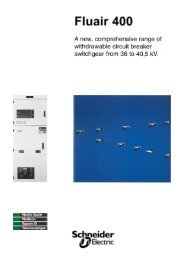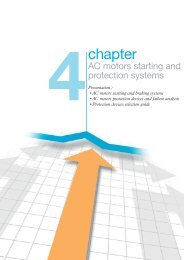Connect - Schneider Electric
Connect - Schneider Electric
Connect - Schneider Electric
You also want an ePaper? Increase the reach of your titles
YUMPU automatically turns print PDFs into web optimized ePapers that Google loves.
1.3 The emergence of sustainable cities<br />
The energy challenge becomes clear in cities, which now contain<br />
50% of the world’s population, responsible for 75% of global energy<br />
consumption and 80% CO emissions.<br />
2<br />
These cities are still growing: by 2050, 70% of the world’s<br />
population will live in an urban environment. Taking into account<br />
demographic growth, over the next 40 years urban capacity will<br />
have to undergo a development equivalent to that experienced over<br />
the last 4,000 years.<br />
1.4 A new geographical balance<br />
The new economies now represent 50% of global GDP and may<br />
reach 65% by 2015.<br />
They account for 90% of the growth in energy needs over the<br />
next 40 years, combining demographic pressure, industrialisation,<br />
urbanisation, and increase in wealth. Millions of men, woman and<br />
children will see their living standards rise.<br />
The driver of global growth is now the new economies – and should<br />
continue to be for years to come.<br />
1.5 A company focussed on growth<br />
From steel to electricity and onto energy management, the Company<br />
created 175 years ago has experienced signifi cant changes in its<br />
activities in order to position itself for growth.<br />
1836-1980: The family SME becomes a major<br />
player<br />
1836: Adolphe and Joseph-Eugène <strong>Schneider</strong> move their foundries<br />
to Creusot and create <strong>Schneider</strong> & Cie two years later. The company<br />
experiences continued development in heavy machinery and<br />
transportation equipment, and becomes an extremely diversifi ed<br />
conglomerate.<br />
1975: Merlin Gerin, one of the top manufacturers of electrical<br />
distribution equipment in France, joins the Group, already present in<br />
the electricity sector since the late 19th century.<br />
1981-2001: The Group refocuses on the<br />
electricity sector<br />
1988: acquisition of France’s Telemecanique, a pioneer in remote<br />
control systems for electric motors.<br />
1991: a major acquisition in the US with the takeover of Square D,<br />
leader in the North American electrical equipment sector.<br />
1997: sale of building and public works company Spie Batignolles.<br />
The Group’s refocusing on the electricity sector is now complete.<br />
1999: the name <strong>Schneider</strong> <strong>Electric</strong> represents the Group’s new<br />
direction and provides a clear indication of its expertise in the<br />
electricity sector. The Group acquires Lexel, Europe’s second<br />
largest supplier of installation systems and control solutions.<br />
DESCRIPTION OF THE GROUP, AND ITS STRATEGY, MARKETS AND BUSINESSES<br />
GLOBAL SPECIALIST IN ENERGY MANAGEMENT<br />
With growth come constraints: infrastructures that lack capacity,<br />
congestion, increased consumption, competition for jobs and skills,<br />
economic diffi culties and ecological ambitions.<br />
To withstand, survive and develop, the cities must become more<br />
sustainable: more intelligent, more effi cient, more liveable.<br />
This will be one of the major challenges over the coming years.<br />
In order to guarantee its sustainable growth strategy, <strong>Schneider</strong><br />
<strong>Electric</strong> already has a signifi cant presence in these new economies,<br />
holding strong positions in Asia (ex Japan), Africa, the Middle East,<br />
Latin America and Mexico, Eastern Europe and Russia.<br />
The Group’s organisation refl ects this new economic balance, since<br />
the <strong>Schneider</strong> <strong>Electric</strong> regional offi ces are found in North America,<br />
Europe and Asia.<br />
2000: acquisition of Crouzet Automatismes, a French leader in<br />
electronic control, small automation devices and customised<br />
sensors, and Positec, a European leader in motion control. Creation<br />
of a joint venture with Toshiba called <strong>Schneider</strong> Toshiba Inverters<br />
(STI) to develop, manufacture and market both partners’ industrial<br />
speed drives. STI, of which <strong>Schneider</strong> <strong>Electric</strong> holds a 60% stake,<br />
leads the global industrial speed drive sector. Launch of <strong>Schneider</strong><br />
<strong>Electric</strong> Ventures fund with capital of EUR50 million, to acquire<br />
interests in innovative start-ups with technologies that can enhance<br />
the Group’s offering.<br />
2001: acquisition of Legrand, a leader in installation systems and<br />
control solutions. The European Commission vetoes the merger,<br />
obliging <strong>Schneider</strong> <strong>Electric</strong> to sell its stake in Legrand. The Court<br />
of First Instance of the European Communities will overrule the<br />
Commission’s decision in October 2002.<br />
2002-2011: Strategic transformation<br />
At the turn of the 2000s, <strong>Schneider</strong> <strong>Electric</strong> radically rethinks its<br />
growth strategy, setting itself three goals:<br />
• to ensure a more balanced exposure to its strategic end markets;<br />
• to enhance its portfolio of traditional activities (electricity<br />
distribution, automation and industrial control); and<br />
• to anticipate the future energy requirements of companies and<br />
individuals.<br />
2011 REGISTRATION DOCUMENT SCHNEIDER ELECTRIC<br />
17<br />
1

















